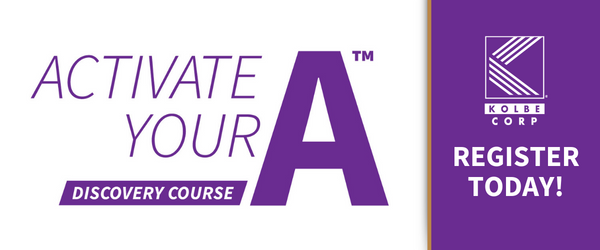Kolbe A Result
You are viewing the Kolbe A Online Result. There is an optimized version for printing available. You will find it via the icon located at the top right of the online version.
You are viewing the Kolbe A Online Result. There is an optimized version for printing available. You will find it via the icon located at the top right of the online version.

Congratulations! You just got your Kolbe A™ Index result and are on the way to discovering what makes you - YOU.
Ready to apply your results to your daily life?
Enroll in the Activate Your A™ Discovery Course for the answers you seek.
Now that you know the power of your MO, it's up to you to use it for good purposes. The world needs your conative strengths!
If scripting is being blocked by your browser, you can simply copy the link...
https://e.kolbe.com/rv/?rt=sppkas&st=K2-7FDD7726-01BF-412E-8D64-0BBB57F6EFB2
Now that you know the power of your MO, it's up to you to use it for good purposes. The world needs your conative strengths!
×You Got a Perfect Score on the Kolbe A™ Index
You’re terrific when juggling rapidly changing priorities. You are known for taking risks that are grounded in practical realities. You don’t mess around with what has always been done, but temper your trial-and-error approach by strategizing options.
How do we know this? You told us when you completed the Kolbe A™ Index. Our proprietary algorithm sorted out your answers and came up with the pattern of your MO (Modus Operandi).
Your Kolbe result is so individualized, only 5% of the population is likely to have one just like it.
 Kathy Kolbe ...
Kathy Kolbe ...The Kolbe A™ Index is an instrument designed to help you focus on your strengths on how you do things when you're free to do them your own way. When you're in the zone, in that glide pattern, when you're able to do what you do best, when you are striving, what do you most or least do? One of the purposes of the Kolbe is to focus on what you do well and just show everybody that you have equal conative abilities that everyone is somewhere on this continuums in the 4 Action Modes. Wherever you are is just fine for you, is just great because there's no good or bad, right or wrong. Who you are is who you were meant to be and the Kolbe Index is validating and celebrating the strengths that you can use in decision making, that are naturally there for you and will always be there for you. These are positives about you.
Kathy Kolbe is the world’s leading authority on human instincts and author of the Kolbe A™ Index. She solved the riddle of how all people can be both equal and different in their creative efforts by identifying the nature of universal instincts that constitute individual modus operandi.









Kolbe Action Modes are behaviors driven by your instinct
* Kathy Kolbe discovered the instinctive Action Modes and authored the Kolbe A™ Index
 Kathy Kolbe ...
Kathy Kolbe ...MO is shorthand for modus operandi, or mode of operation. Kolbe has 4 modes, so we could say modes of operation, but to summarize - it is your innate pattern of taking action, the behaviors that you will use in any situation, any day, any time, as long as you are striving, and as long as you are working toward either a decision or some kind of action in the creative problem solving process.
Your MO doesn't come into effect when you're relaxed or doing recreational things. At that time you're not striving, but anytime you are, your modus operandi - your MO - that pattern of action, will be in place.
An Action Mode is a cluster of behaviors that are derived from instinct. In a sense instinct is a subconscious force. We can't measure that, but we can measure the actions that we can see, observe, and report. There's a continuum of behaviors in each of the Action Modes. No matter where you are in that continuum, it is equal in strength. To help you summarize where you are, we've given you the number from 1 to 10.
Kathy Kolbe is the world’s leading authority on human instincts and author of the Kolbe A™ Index. She solved the riddle of how all people can be both equal and different in their creative efforts by identifying the nature of universal instincts that constitute individual modus operandi.
gathers and shares information
arranges and designs
deals with risk and uncertainty
handles space and tangibles
gathers and shares information
arranges and designs
deals with risk and uncertainty
handles space and tangibles
Your Kolbe result celebrates your Modes of Operation (MO): 6-3-7-4. It doesn’t have anything to do with what your social style is or how smart you are. It’s how you will and won’t naturally take action.
Kolbe adds a new dimension. Based on wisdom going back to Plato and Aristotle, the Kolbe Theory™ has proven successful with over one million users.
Conables® Tips, individualized for you, will not only help you explain your way of taking action, they will help you control the outcomes. For example:
Understanding and trusting this powerful force will give you the freedom to be yourself.
 Kathy Kolbe ...
Kathy Kolbe ...Fact Finder is a Kolbe Action Mode. It's the term for how you deal with gathering information. There's a continuum in Fact Finder from doing things in a very simple overview way to a very complex specific way. At one end, the 1, 2, 3, level of Fact Finder, you generalize. At the other end, up to the 10, is how you become an authority or an expert.
Everybody has a way of gathering information, you have a particularly wonderful ability because you're right in the middle of the continuum where you can help people who'll simplify information and abbreviate, and give enough information to those who need more specificity. You're the bridge between those opposite ways of gathering information. You're not only good at explaining things to both sides of that continuum, you're excellent at refining and editing; pulling together information in a way that makes it digestible for people.
Kathy Kolbe is the world’s leading authority on human instincts and author of the Kolbe A™ Index. She solved the riddle of how all people can be both equal and different in their creative efforts by identifying the nature of universal instincts that constitute individual modus operandi.
Do |
 |
Don't |
 |
For instance, you might:
Do |
 |
Don't |
 |
 Kathy Kolbe ...
Kathy Kolbe ...Follow Thru is a Kolbe Action Mode. It's a term we use for that method of taking action that deals with organizing, storing, and sorting information. At the low number end of Follow Thru, it's an ability to be highly adaptive and multi-task. At the high end, it's being very, very systematic where you put things into sequence and where you build in a lot of structure. It ranges from chaos to highly organized, or sequential.
In the Follow Thru mode, there's a continuum from being highly adaptable to being very well-organized, structured, and sequential. Your place on this continuum, your natural talent, is to be that person who's adaptable, to be at the end of the continuum where you're the person who multitasks. Not many people in the population have this knack that you have. Without people like you, what would happen is we wouldn't take advantage of opportunities. You are so terrific at moving when you need to move outside the box.
Kathy Kolbe is the world’s leading authority on human instincts and author of the Kolbe A™ Index. She solved the riddle of how all people can be both equal and different in their creative efforts by identifying the nature of universal instincts that constitute individual modus operandi.
Do |
 |
Don't |
 |
For instance, you might:
Do |
 |
Don't |
 |
 Kathy Kolbe ...
Kathy Kolbe ...Quick Start is the Kolbe Action Mode that deals with risk and unknowns. We all have to take risks. We all have to deal with unknowns. At the 1-2-3 level in Quick Start is where you bring stability, where you deal with what is known, and you try to manage risk so there are as few unknowns and as little risk at possible. At the high number end in Quick Start is how you innovate or improvise, or just take a risk without having to know what the outcome will be.
You're the go-to person when it comes to taking risks. This Quick Start continuum is a fun one to watch in a group, in a family, in any place where you are. You're at the end of the continuum where they're going to turn to you say and well, what do you think we should do? What's next? Do you have any ideas, and yes you do. You're there, ready, able, and willing to come up with alternatives with other ways of doing it. Taking chances, beating the clock, taking on challenges, and the way you do this is so innate, so natural that you don't even have a sense that other people don't do that, but look at where you are in the continuum. Look how many people are at the other ends of the continuum, and in the middle, and they sometimes have difficulty keeping up with you. They're not always sure where you're headed, because you don't know. You're experimenting. You're exploring, you're trying it on and seeing what's going to happen. It's really important for you not to try to justify or explain your ideas in advance. Just go for it.
Kathy Kolbe is the world’s leading authority on human instincts and author of the Kolbe A™ Index. She solved the riddle of how all people can be both equal and different in their creative efforts by identifying the nature of universal instincts that constitute individual modus operandi.
Do |
 |
Don't |
 |
For instance, you might:
Do |
 |
Don't |
 |
 Kathy Kolbe ...
Kathy Kolbe ...Implementor is the Kolbe Action Mode through which we deal with the instinct to handle things, literally. It's a scale from the abstract to the concrete. At the 1, 2, 3 level, you imagine results. You don't have to touch and feel them, you just are able to look at them from inside your head or from a distance, or hear on the phone what's happening. At the other end it's very concrete. You need to touch it, actually interact with it, deal with the 3 dimensional aspect of it, to build it, to be very concrete, to construct.
On this Implementor continuum you don't have to deal with just the abstract or the concrete, you don't have to build it or imagine it. You're able to do both to some degree. You restore what's already built and you renovate it, and you can do enough imagining of what that's going to look like that you don't have to worry that you have all the drawings there, or that you have all of the technical ability to make it happen. You can communicate with other people about how you need to have something physically happen or done for you. You're a good communicator in this Implementor dealing with the environment, dealing with tangible three dimensional items. This is an important talent because the world requires that we deal with all the things, and that we are able to do the hands on.
Kathy Kolbe is the world’s leading authority on human instincts and author of the Kolbe A™ Index. She solved the riddle of how all people can be both equal and different in their creative efforts by identifying the nature of universal instincts that constitute individual modus operandi.
Do |
 |
Don't |
 |
For instance, you might:
Do |
 |
Don't |
 |
 Kathy Kolbe ...
Kathy Kolbe ...People have a sense of how smart they are, how good they are in different kinds of skills. You knew when you were put in the “Red Bird” reading group or the “Blue Bird” reading group where you kind of fit in on the bell-shaped curve in the cognitive and emotionally and affectively, you know whether you're an introvert or extrovert. There are instruments that will help identify that for you. Kolbe is different. It doesn't deal with either your IQ, or your social style, or personality. It is the only validated instrument that has proven absolutely reliable in predicting your actions, how you will do things, how you get things done best. I can predict what works for you and what doesn't. I say can because you're the one that completes it. This is important because this is the one part of you that is unchanging. This is the one thing you can count on. It's the core of your being, it's essence of you. It's not going to change.
Kathy Kolbe is the world’s leading authority on human instincts and author of the Kolbe A™ Index. She solved the riddle of how all people can be both equal and different in their creative efforts by identifying the nature of universal instincts that constitute individual modus operandi.
Being a 6-3-7-4 in Kolbe has nothing to do with your personality, social style, or if you are a math whiz. Kolbe Index results deal with a different part of the brain/mind that drives your actions.
You can’t get time back – once it’s used, it’s gone – but energy can be renewed.
Your 100 “ergs” of mental energy are equal to the energy available to every other human being. This gives you the same potential power as any CEO or rock star.
Pyramid of Energy.
Explain
30%
Adapt
15%
Innovate
35%
Restore
20%
Each of your 100 ergs has the same intensity - whether it is in the Initiating, ReActing, or CounterActing zone.
A lot of your time is spent trying to come up with ideas. The good news for you is that you naturally edit out the really goofy ones. You may leap toward a goal with uncertain complications, but your Fact Finder strength quickly ascertains whether you can live with the results and makes sure you’re not wasting time on low-priority tasks. Your other conative strengths kick in to polish the process.
Don’t let anyone stereotype you as contributing or “being” just one of the Action Modes. Your contribution begins with innovating and continues until you adapt the solution.
Self-manage your use of these limited, but renewable, resources. Use them purposefully and they will bring joy to your life.
It’s tough to allocate your time, especially when no one but Kolbe has explained the role of your conative assets.
You use time according to your MO. So forget time management advice that doesn’t take it into consideration. Everyone has an equal amount of conative energy, used in differing amounts and orders. You use it in your particular order and percentages per mode.
Quick Start
35%
Fact Finder
30%
Implementor
20%
Follow Thru
15%
When free to use your strengths:
1. You’ll start the problem solving process by brainstorming.
2. Next you review data.
3. Then, you check the strength and durability of available materials.
4. Finally, Alan, you look for several alternative routes.
If you work against your grain, you’ll never have “enough” time. You will squander it by taking non-productive paths.
We can't give you more time, but we have proven leveraging your conative strengths can more than double your productivity.
Here are some ways you can get the multiplier effect from your MO of 6-3-7-4.
Give it urgency or give it away.
Because most of the world hasn't recognized conation, you may actually have been taught ways of taking action that are absolutely wrong for you.
Don't just take our word for it; try it! You may surprise yourself with how much you can get done, and by how natural it feels.
You’re likely to procrastinate if you have to fill in lots of forms.
When you need to be persuasive in an unfamiliar situation, wing it. Trust your guts to pull out the right examples and call it as you see it.
You may be acting against your grain without even knowing it. When we work against our grain, we are not only unhappy but also unproductive, wasting our time on things that require too much energy. Instead of robbing yourself of your valuable time and energy, modify the things you need to do so that you can accomplish them in your own way.
Join us for a FREE Webinar to deepen your understanding of your instinctive strengths and use them to improve your life.
Listen to customized audio of Kathy Kolbe discussing YOUR initiating strengths. Gain great insight into how to make them work for you in the Natural Advantage - Entrepreneur Audio (check Audible.com or iTunes to purchase download).
Communication involves Action, ReAction, CounterAction and InterAction. Of course, emotions cause the desire to communicate while thoughts provide the content. However it’s your conative instincts that drive how it plays out.
If you aren’t communicating through your conative strengths, you are likely to come across as acting out of character or not being authentic.
We’re taught that there is a “right way” to do things. Our essays have the same structure and our resumes look like we’ve all had the same experiences.
How can you be true to who you are, and win approval too? We give you individualized Conables Tips for communicating in your own way without turning other people off.

If everyone around you knew who you are, you could get three times as much done. You have moments with rapid-fire tossing out of ideas (some you’ve never heard until you said them out loud), and your immediate action is to sell them. Your explosion of “what ifs” needs to be understood as starting points. It’s not until you’ve had time to step back and consider the consequences of them that you begin to pick the practical ideas.
You need the freedom to speak up and shout out, yet the time to write it down and read it back. People who only see one side of your conative process may stereotype you – to everyone’s detriment.
It’s important for you to know the conative strengths around you, just as it’s important for them to know yours. Build a team around you that understands the way you work and let ideas simmer without judgement for at least a little while.
There is no perfect combination of Kolbe results for relationships. The ideal spouse, child, sibling, parent, grandparent, colleague or friend will respect your conative truth and allow you the freedom to be yourself.
“Trying to avoid conflict between people with strong conative differences is impossible. No use pretending – it will come out sooner or later. Discussing the differences doesn’t resolve them. It involves them. It turns a clash of wills into a meeting of the minds. You are impelled to act according to your instincts, but you can’t compel others to respond the same way.”
Conative Connection by Kathy Kolbe
People trust what they sense comes from your conative truths.

You can improve relationships by understanding similarities and differences in your conative MOs.
In situations with someone who is pretty much your conative clone, you might be able to finish each other’s sentences, but it could also lead to: inertia in what you do together or competition for who could do things better or more than the other.
When working with someone whose MO is similar to your own:
In situations with a person who has very different conative strengths than you do, you can benefit from the resulting Synergy, or the differences can cause conflict and stress.
When working with someone whose MO is very different than yours:
Alan, you do your best work when you strive according to your MO. You're most likely to succeed in jobs that use your conative strengths according to each of the Action Modes.

Review, confirm, report, substantiate, amend

Diversify, disguise, diffuse, randomize, switch

Speculate, discover, originate, promote, experiment

Renovate, repair, reproduce, upgrade, simulate
You have many strengths that could contribute to an organization.
In job interviews, people often say things they think employers want to hear. Yet if they get a job based upon false promises, they usually become frustrated and regret having to live up to them.
Finding a job that lets you use your natural strengths is a formula for success.
Kolbe Corp has partnered with OPgigSM to provide a career guidance system that incorporates both conation and interests. Kathy Kolbe developed this program, which has a new algorithm and is sold separately from the Kolbe A Index. Click here to go to OPgig.com and receive a great discount!
The Kolbe B™ Index measures an individual's perception of their own job responsibilities. Comparing your Kolbe B Index result with your MO (in this Kolbe A Index report) will reveal if and where you may be working against your grain.
Alan, the information in every section of this report was individualized for you, whether you remember it by:
However you visualize your MO – it's important to keep the message of your conative strengths in the front of your mind as you make life empowering decisions.
Now that you know the power of your MO, it's up to you to use it for good purposes. The world needs your conative strengths!
We hope you find this analysis will help you maximize your time and energy and communicate more effectively.
If you took the Index through your organization, check back with your Kolbe Consultant or Administrator for additional services.
We have solutions to help you take this knowledge and insight to the next level. Check out customized Kolbe Solutions to help you improve your life and build your business!
Contact us for more information: info@kolbe.com or 602-840-9770.

Congratulations! You just got your Kolbe ATM Index result and are on the way to discovering what makes you - YOU.
Have Questions? Join us for a FREE Webinar all about applying your results to improve your life.
CLICK TO LEARN MORE